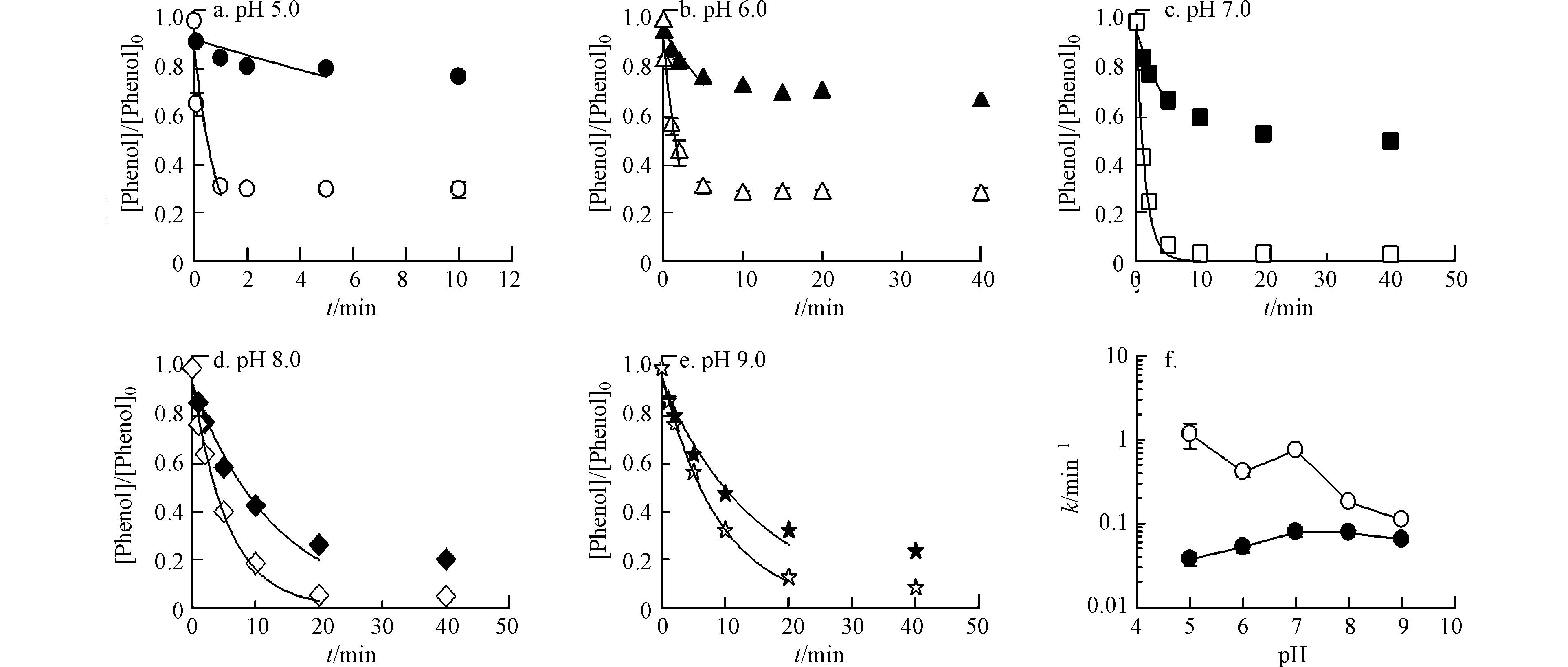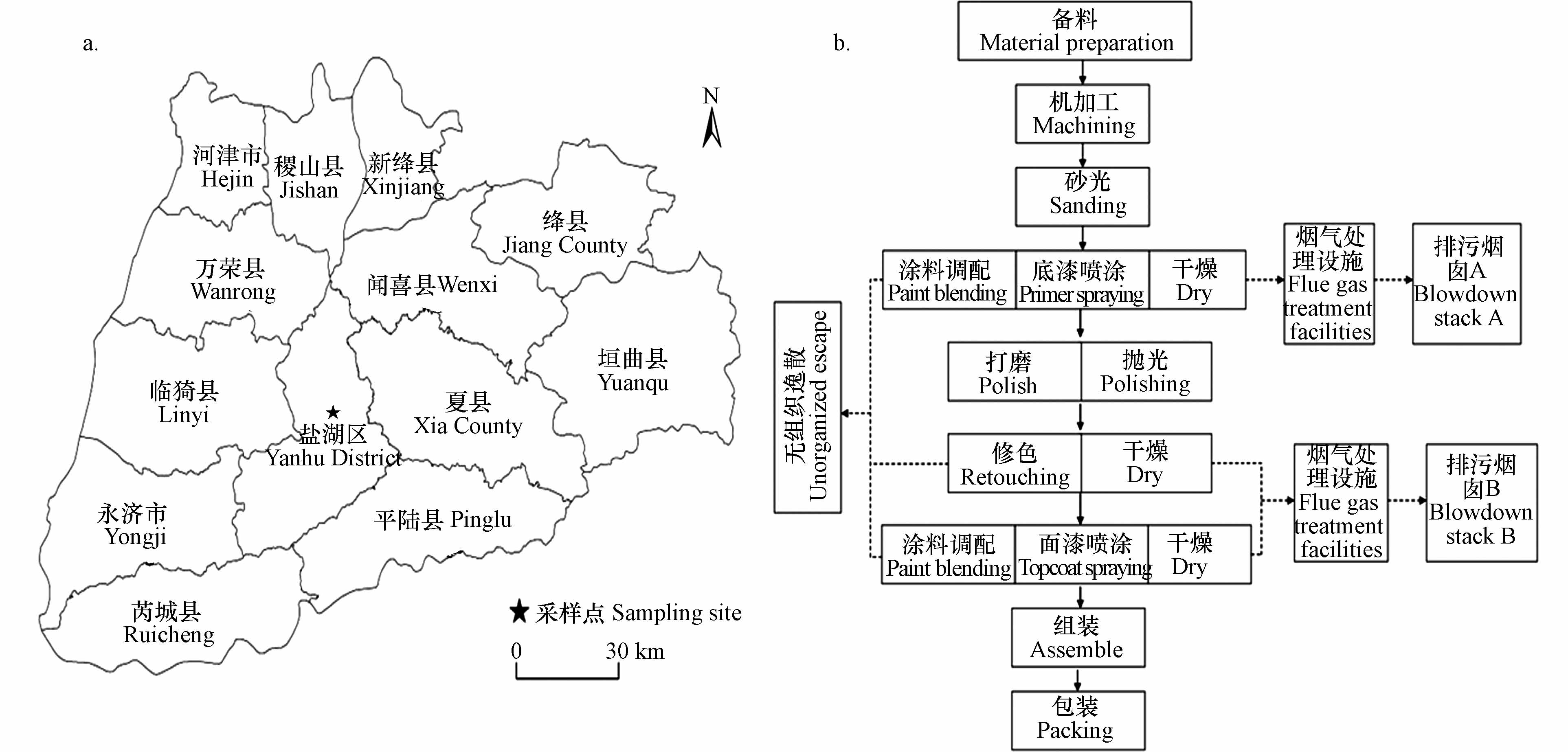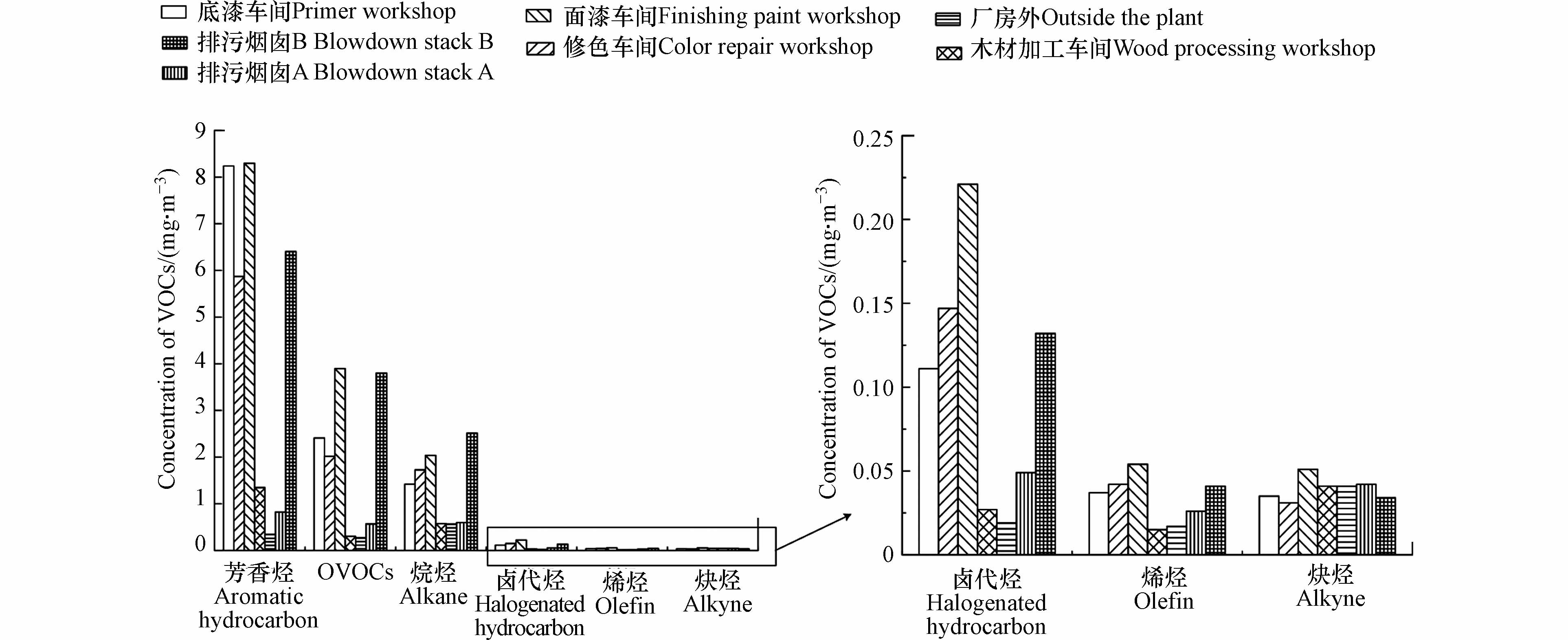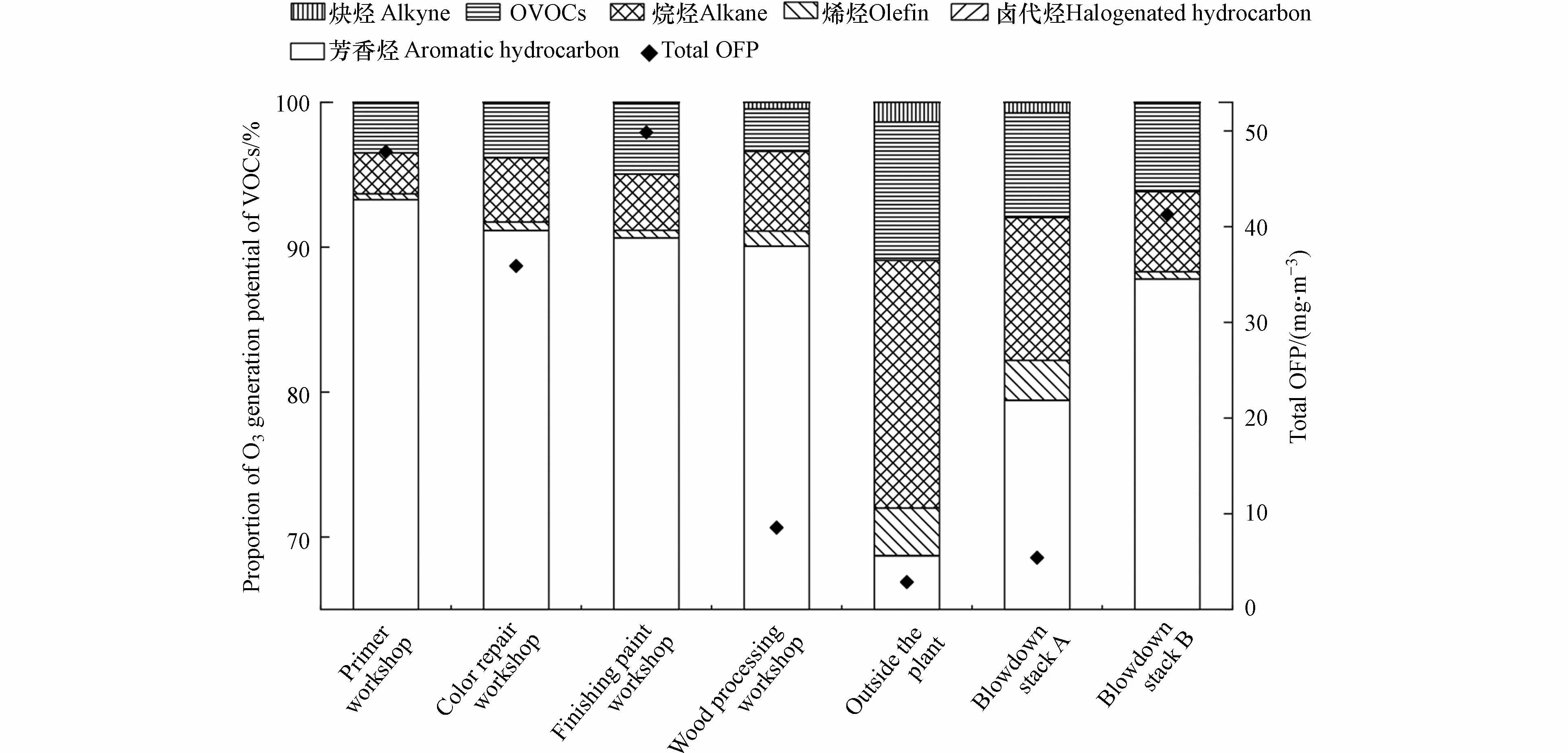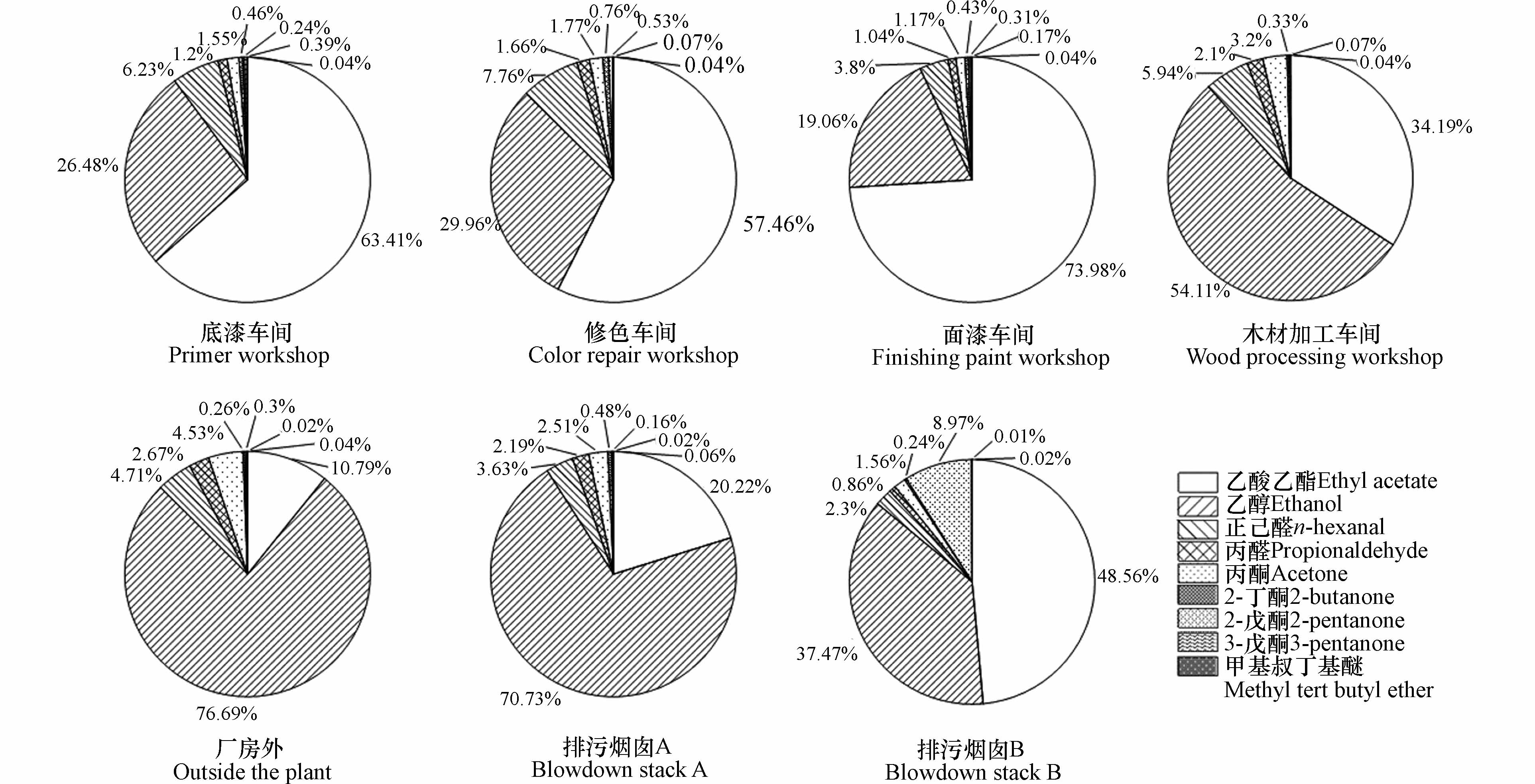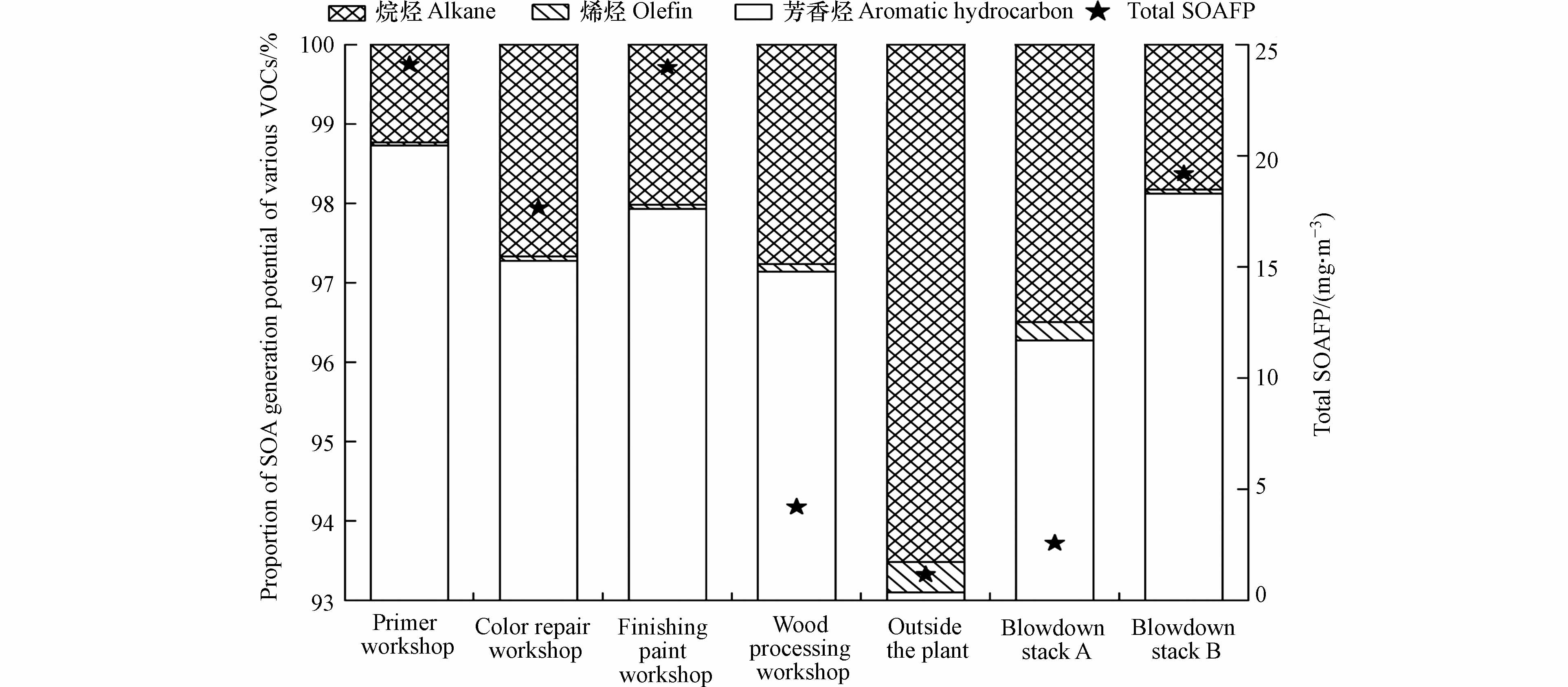-
随着我国城市化和工业化发展进程的加快[1],人们逐渐认识到治理环境污染的重要性,其中大气污染成为诸多专家学者的研究热点[2]. 目前,我国大气污染的主要特征为细颗粒物(PM2.5)和臭氧(O3)复合污染[3],挥发性有机物(VOCs)是细颗粒物和臭氧共同的重要前体物[4 − 5],主要来源于人为源和光化学源,在光照条件下,与空气中氮氧化物(NOx)发生光化学反应[6],生成臭氧(O3)和二次有机气溶胶(SOA),这是灰霾形成的主要原因之一[7]. VOCs种类繁多、成分复杂[8],具有低浓度、强活性、高危害等特点[9],其中一些是已知的致癌物,含有一定的毒性[10],对大气环境和人体健康均会产生危害[11],治理VOCs刻不容缓.
近些年,针对燃烧源、道路移动源、工业过程源、工业溶剂源等重点VOCs排放源的研究取得了突破性进展. Chandra等[12]使用13种VOCs对生物质燃烧源研究进行优化,定量重复性好,总不确定度≤30%,可储存15 d;在不同相对湿度下,每个热解吸管(10—150 ng)的校准具有良好的线性(R2≥0.90). Yang等[13]评估了工业锅炉形成O3、SOA的潜势,芳香烃是燃煤、燃油锅炉共同的主要组分,主要物种为苯、甲苯等苯系物. Wang等[14]对道路机动车尾气VOCs的研究表明,芳香烃和烷烃是最主要的组分,占比为68.1%—98.0%. Saber等[15]研究表明,PAHs是焦化厂的主要化合物,浓度分别为84.4 μg·L−1、30.7 μg·L−1. 李世杰等[16]测定了6类家具板材排放的VOCs浓度,结果表明,TVOCs的8 h平均值在0.1—0.7 mg·m−3不等,主要物种为甲苯、甲醛、正壬烷等. 家具制造业作为典型工业溶剂源[17],包亦姝等[18]对成都市家具制造业的研究表明,芳香烃和OVOCs是主要组分,主要物种为邻二甲苯、间二甲苯等苯系物,占比39.8%. Qi等[19]研究表明,家具涂装车间的主要物种是乙酸乙酯、n-乙酸丁酯、乙酸仲丁酯等含氧VOCs. 在Tong等[20]对珠江三角洲家具业的研究中表明,饱和脂肪酸酯、芳香烃和酮是主要组分,占比为63.31%、45.3%和35.1%,其中乙苯、二氯甲烷和苯是工人致癌风险的主要来源. 齐一谨等[21]研究了郑州市家具制造业的VOCs排放成分,主要为间/对二甲苯、邻二甲苯等C7—C8苯系物. Yuan等[22]研究指出,甲苯、乙苯和二甲苯等苯系物是北京家具企业的主要排放物种. 家具制造业的研究多集中于京津冀、珠江三角洲或其他内陆经济较为发达地区,关于汾渭平原的研究相对较少,VOCs成分源谱相对匮乏. 该研究选择运城市为对象,详细分析其VOCs排放特征及环境影响,以期为当地科学有效地降低该行业对环境空气质量影响提供参考,丰富本地化的源谱研究进展,进而对运城市大气污染治理起到一定的指导作用.
-
经过对生产工艺、企业规模等因素深入研究调查选取的家具制造企业,是一家集研发、生产、销售、服务为一体的中国一流现代化木制品生产企业,拥有现代化生产车间,形成了年产木门45万套和全屋定制3万套家具的生产能力,是中国北方地区具规模及实力的专业木制品出口外贸型生产企业,在运城市家具制造业中具有较高的代表性,企业点位如图1(a)所示. 该研究所选企业的生产工艺流程及排污节点如图1(b)所示,VOCs气体主要在喷漆、干燥等工序产生,因该企业所用PU型涂料含VOCs物质,在调配过程亦存在VOCs气体逸散现象. 该企业配料调配、喷漆和干燥在同一车间完成,底漆车间的VOCs废气经过收集处理后,经排污烟囱A排出,排污烟囱B排放的废气则来自于面漆车间和修色车间.
-
样品采集使用气袋采样法,以《固定污染源废气挥发性有机物的采样-气袋法》(HJ 732—2014)为参照标准,无组织排放源使用大气采样仪(QC-IS系列,北京市科安劳保新技术公司)采样,距地面1.5 m,距生产线约1 m,采样标准参考《大气污染物无组织排放监测技术导则》(HJ/T 55—2000);有组织排放源则是使用烟气采样探枪靠近烟道中心位置采样,采样标准参考《固定源废气监测技术规范》(HJ/T 397—2007),采样流量设置为100 mL·min−1,使用容积为3 L的Tefion气袋收集,保存于避光阴凉干燥处,并及时完成样品分析. 样品均来源于工业园区,采样期间生产设施正常运转,采样点设置详情见表1,该企业共采集12个样品,其中平行样占本批次样品的41.7%,计算数据使用平行样品的均值.
-
该研究先抽取稀释后的400 mL样品,进入三步预浓缩进样系统(Entech 7200,Entech Inc,美国),在捕集器之前,将内部标准添加到样品流中,设置参数为:冷阱1冷冻温度为-40 ℃,解吸温度10 ℃;冷阱2冷冻温度为-60 ℃,解吸温度200 ℃;冷阱3深冷温度-160 ℃,载气为氦气. 后经热解吸,采用气相色谱-质谱/氢火焰离子化检测器(GC-MS/FID,型号为Thermo trace DSQⅡ)对样品进行定量分析,气相色谱部分设置参数为:进样口温度150 ℃,传输线温度200 ℃,柱前压137 kPa,不分流,恒压模式,载气为高纯氦气,FID温度240 ℃,升温程序:30 ℃保持10 min,以3.8 ℃·min−1升至90 ℃停留1 min,15 ℃·min−1升至130 ℃,8.5 ℃·min−1升至200 ℃停留10 min. 质谱部分设置参数为:离子源温度220 ℃;电离方式为电子轰击(EI),电离能为70 eV;电子倍增器电压1750 V(自调);全扫描方式,扫描范围45—200 amu,扫描频率4.21 scans·s−1. 定量方法使用外标法. 经过该分析方法,运城市该家具制造企业共检测到74种VOCs物质,包括9种卤代烃、16种芳香烃、27种烷烃、9种烷烃、1种炔烃和12种OVOCs,其样品色谱图如图2所示.
-
该研究的样品采集和分析过程始终在标准规定下进行,切实保证质量保证与质量控制贯穿采样前准备、现场采集、样品保存和运输、以及样品分析与数据处理等全过程.
开始采样前,气袋先使用高纯氮气(≥99.9%)进行3次润洗,排净残存气体,结束后迅速关闭气袋阀门,放入干燥洁净的塑封袋中保存备用;现场采样时,先经目标气体润洗3遍气袋以减少本底影响. 采样过程中,保证采样系统的密封性良好,严格控制采样流速在100 mL·min−1,误差应小于5%.
利用静态稀释法对TO-14标气和烷烃、烯烃标气(Spectra/Linde,LiDa)稀释成不同浓度,建立多点标准工作曲线. 选取7个体积分数(2×10−9、4×10−9、6×10−9、8×10−9、10×10−9、20×10−9、40×10−9)的标准化合物均连续进样3次,RSD<30%,取其平均保留时间和平均响应值建立标准曲线,相关系数r>99%,质量控制指标符合规定要求. 使用中间浓度对工作曲线的有效性进行日校正,定量结果与实际浓度偏差小于30%;采用4-溴氟苯对GC/MS仪器进行调谐校正.
-
臭氧生成潜势(ozone formation potential,OFP)是指在最佳反应条件下VOCs物种浓度和该物种的最大增量反应活性(maximum incremental reactivity,MIR)的乘积[23],计算公式如下:
式中,OFPi表示物种i的最大臭氧生成潜势,mg·m−3;MIRi表示VOCs物种i的最大增量反应活性,该研究中所涉及的系数参考Carter等[24 − 25]、邱婉怡等[26]的研究成果;ci表示VOCs物种i的排放浓度,mg·m−3.
-
SOA是有机气溶胶的最大组成部分,可通过VOCs的光化学氧化产生[27],二次有机气溶胶生成潜势(secondary organic aerosol formation potential,SOAFP)经常被用作描述VOCs的二次气溶胶的生成贡献[28],应用最为广泛的是气溶胶生成系数法[29 − 30],计算方法如下:
式中,SOAFPi表示SOA生成潜势,mg·m−3;FACi为物种i的气溶胶生成系数,FAC值采用Grosjean等[31]、吕子峰等[32]、Dechapanya等[33]的研究;ci表示VOCs物种i的排放浓度,mg·m−3.
-
通过对该企业各生产环节的VOCs成分浓度进行分析,结果如下图3所示,无组织排放源的VOCs浓度在1.25—14.56 mg·m−3之间,其中,面漆车间的TVOCs浓度最大;有组织排放源中的烟囱A、B的浓度差距较大,且低于相应车间的VOCs浓度,分别是2.10 mg·m−3、12.92 mg·m−3,主要成分为芳香烃>OVOCs>烷烃,同处理前成分占比较为一致.
该企业生产车间在工作时间内为全封闭状态,集气罩全面覆盖生产线,车间内无组织逸散的VOCs废气收集状况良好,末端尾气处理采用水过滤+活性炭吸附工艺,烟囱B各成分的浓度变化差距较小,其原因可能是因为烟囱B承担着来自修色车间和面漆车间共同的烟气末端处理,存在混合效应,但烟囱A排放后的VOCs各主要成分的浓度削减程度较高,原因可能是该处理工艺在流量较小、浓度较低的情况下处理效果更佳,烟气流量和浓度过大时,活性炭与烟气无法得到充分的接触和吸附,烟气中的颗粒物易造成过滤设施堵塞,活性炭未及时更换也会降低吸附效果[17],该企业需进行技术升级或增加活性炭更换频次以保证理想的烟气处理效率.
-
通过对各VOCs成分的分析发现,芳香烃占比最大,在39.0%—68.0%不等,OVOCs次之,在13.0%—30.0%,烷烃占比10.0%—28.0%;在厂房外占比最大的是烷烃,为45.2%,其次是芳香烃和OVOCs,分别占比27.2%和21.5%. 芳香烃、OVOCs、烷烃、卤代烃以及烯烃在厂房外的含量明显低于烟囱A、B,可能是因为厂界较强的空气流通性有利于挥发扩散,芳香烃本身具有较强的活性,光化学反应速率较快. 如图4所示,家具制造业各生产工艺之间前10种物质虽然占比存在差异,但是种类基本相同,均以乙苯、间/对二甲苯、乙酸乙酯等为主要物种. 在OVOCs各组分中浓度最大的为乙酸乙酯,浓度在0.05—3.04 mg·m−3之间,其次为乙醇和丁烯酮,分别为0.09—0.32 mg·m−3和0.03—0.41 mg·m−3.
-
如表2所示,与京津冀、珠江三角洲等为代表的经济发达地区以及同运城市经济水平类似的德州市做家具制造业同行对比发现,受涂料类型的不同,在不同地区排放的特征VOCs物种呈现出显著的差异,但多数研究表明,芳香烃和OVOCs是主要的VOCs组分,关键活性物种基本都包含甲苯、乙苯、乙酸乙酯、间/对二甲苯、邻二甲苯等. 在王瑞鹏等[34]的研究中,车间和排口存在的主要物种虽然占比不同,但物种基本一致,此类现象与该研究相似. 此外,在该研究中发现较大比重的烷烃类物质,这与方莉等[35]的研究相似.
-
图5是针对该企业不同环节排放VOCs的O3生成潜势的分析. 面漆车间的OFP值最高,为49.86 mg·m−3,厂房外最低,为2.86 mg·m−3;底漆车间、修色车间、面漆车间以及排污烟囱B的臭氧生成潜势均不低于35 mg·m−3,木材加工车间、厂房外、排污烟囱A的OFP值均不高于10 mg·m−3. 可以看出,不同生产环节对OFP的贡献存在较大差异,一方面这与其本身的VOCs浓度水平有关,另一方面也和各物质的MIR值相关. 在家具制造业中,芳香烃对OFP的贡献占比最大,占比在65%—93.28%不等,其次是OVOCs和烷烃,占比均在2%—18%,卤代烃对OFP的贡献可以忽略不计. 关键活性物种为间/对二甲苯、邻二甲苯、乙苯等,这3种物质的总占比超过85%,今后可以考虑加强对该3种物质的重点监测.
根据包亦姝等[18]、齐一谨等[21]、秦华等[38]对家具制造业的研究,对OFP贡献最大的组分为芳香烃,占比在75.40%—94.29%不等,该研究的芳香烃占比也在此范围;对O3生成贡献较大的物种为间/对二甲苯、邻二甲苯、甲苯、乙苯等C7—C8苯系物,该研究的关键活性物种与此结果类似. OVOCs因为较高的活性逐渐成为目前的研究热点,在家具生产过程中,释放的VOCs组分中含量丰富,如图6所示,对OFP贡献较大的活性物质为乙酸乙酯和乙醇,占比分别在10.79%—73.98%和19.06%—76.69%,其次是正己醛、丙醛和丙酮,占比分别在2.30%—7.76%、0.86%—2.67%和1.17%—4.53%.
-
在对不同生产环节排放的VOCs的SOAFP进行分析,结果由图7可知,烯烃占比最高不超过1%,在大部分生产环节中可以忽略不计. 底漆车间、修色车间、面漆车间与排污烟囱B的SOAFP值在17.0—25.0 mg·m−3,其中以底漆车间的SOAFP值最大;木材加工车间、厂房外与排污烟囱A对SOAFP贡献较小,分别为4.20、1.15、2.57 mg·m−3. 其中,芳香烃对SOAFP的贡献占比最大,各生产环节均大于93%,是SOAFP的最主要贡献者;其次是烷烃,该类组分在厂房外占比最大为6.52%. 关键活性物质为间/对二甲苯、邻二甲苯、甲苯等C7—C10苯系物、癸烷等C8—C11烷烃类物质.
曾春玲等[36]研究表明,甲苯、乙苯和二甲苯等C7—C8芳香烃是溶剂型涂料、溶剂型UV涂料、水性涂料和粉末涂料废气中主要SOAFP贡献者,占比均超过99%;而水性UV涂料废气中SOAFP贡献者以1,2,3-三甲苯、乙苯和氯苯为主,占比分别在45.13%、23.57%和13.85%. 张嘉妮等[39]研究表明,对SOAFP贡献最大的组分为芳香烃,占比在95.42%—100.0%不等,对SOAFP贡献较大的物质分别为甲苯、间二甲苯、乙苯、邻二甲苯等C7—C10苯系物. 该研究结果与曾春玲等、张嘉妮等的研究成果具有较高的相似性.
-
本研究为了解决运城市家具行业VOCs成分源谱匮乏的问题,进行了该行业VOCs排放特征及环境影响的分析,得到了如下结论:
(1) 各生产环节的TVOCs浓度在1.25—14.56 mg·m−3不等,面漆车间的TVOCs最大;主要VOCs组分为芳香烃、烷烃、OVOCs,其次是烯烃和卤代烃,主要物种为乙苯、间/对二甲苯、乙酸乙酯等.
(2) 面漆车间的OFP值最高,为49.86 mg·m−3,厂房外最低,为2.86 mg·m−3. 芳香烃是OFP的主要贡献者,占比在65%—93.28%不等,其次是OVOCs和烷烃,占比均在2%—18%. 对OFP值贡献较大的VOCs物种为间/对二甲苯、邻二甲苯、乙苯等;乙酸乙酯和乙醇是对OFP贡献较大的主要OVOCs物种.
(3) 各生产环节的SOAFP值在1.15 — 25.0 mg·m−3不等,SOAFP的最主要贡献者是芳香烃,其次为烷烃;关键活性物质为间/对二甲苯、邻二甲苯、甲苯和癸烷等.
运城市某家具制造厂VOCs排放特征及环境影响分析
Characteristics of VOCs spectrum and environmental impact of a furniture factory in Yuncheng City
-
摘要: 为研究汾渭平原运城市家具制造业VOCs排放特征,选取运城市一家具有代表性的家具制造企业作为研究对象,利用气相色谱-质谱/氢火焰离子化检测器(GC-MS/FID),采用外标法定量分析了挥发性有机物(VOCs)浓度排放特征,并估算了其臭氧生成潜势(OFP)与二次有机气溶胶生成潜势(SOAFP). 研究显示,底漆车间、修色车间、面漆车间、木材加工车间、厂房外、排放烟囱A以及排放烟囱B的TVOCs浓度在1.25—14.56 mg·m−3,烟囱A和B采用水过滤+活性炭吸附工艺对末端烟气进行处理,该工艺对烟囱A各VOCs组分具有较好的处理效果;该家具制造厂排放的主要VOCs组分为芳香烃、OVOCs和烷烃,占比分别为39.0%—68.0%、13.0%—30.0%和10.0%—28.0%,其中,主要物种为乙苯、间/对二甲苯、乙酸乙酯等;对OFP贡献较大的组分为芳香烃,占比为68.70%—93.28%,其次是OVOCs和烷烃,占比在2.82%—17.09%,对OFP贡献较大的前3种物质分别为间/对二甲苯、邻二甲苯、乙苯;SOAFP的绝对贡献者是芳香烃,占比为93.10%—98.73%,对SOAFP贡献较大的前4种物质分别为间/对二甲苯、邻二甲苯、甲苯、癸烷. 因此,运城市该家具制造企业需要加强对芳香烃等活性较高的VOCs组分的监管与控制力度,希望该研究可以为其提供一定的指导意义.
-
关键词:
- VOC源谱特征 /
- 汾渭平原 /
- 家具制造业 /
- 臭氧生成潜势(OFP) /
- 二次有机气溶胶生成潜势(SOAFP).
Abstract: In order to study the VOCs emission characteristics of furniture manufacturing industry in Yuncheng City of Fenwei Plain, a representative furniture manufacturing enterprise in Yuncheng city was selected as the research object, and the emission characteristics of volatile organic compounds (VOCs) were quantitatively analyzed by using gas chromatogenic-mass spectrometry/hydrogen flame ionization detector (GC-MS/FID) and external standard method. The ozone formation potential (OFP) and secondary organic aerosol formation potential (SOAFP) were estimated. According to the study: The concentration of TVOCs, including the primer workshop, color repair workshop, finish paint workshop, wood processing workshop, outside the workshop, discharge chimney A and discharge chimney B was 1.25—14.56 mg·m−3. The end flue gas was treated by water filtration + activated carbon adsorption process in chimney A and B, which had a good treatment each VOCs component of chimney A. The main VOCs emitted by the furniture factory can be divided into aromatic hydrocarbons, OVOCs and alkanes, accounting for 39.0%—68.0%, 13.0%—30.0% and 10.0%—28.0%, respectively, among which, the main species were ethylbenzene, m-paraxylene, ethyl acetate, etc.The group with high contribution to OFP was divided into aromatic hydrocarbons, accounting for 68.70%—93.28%, followed by OVOCs and alkanes, accounting for 2.82% —17.09%. The top three substances with high contribution to OFP were m/p-xylene, o-xylene and ethylbenzene, respectively. The absolute contributors of SOAFP were aromatic hydrocarbons, accounting for 93.10%—98.73%, and the top four substances that contribute more to SOAFP are m-paraxylene, o-xylene, toluene and decane, respectively. Therefore, more attentions should be pay for the furniture manufacturing enterprise to supervision and control of VOCs components, especially for the high activity such as aromatic hydrocarbons. -
高铁酸盐(Fe(Ⅵ))是一种环境友好的氧化剂[1],与含有富电子基团的有机微污染物(例如胺类[2-3]、硫醇硫酯类[4]、酚类[5])具有较高的反应活性. 与二氧化氯、高锰酸盐、臭氧和次氯酸盐等常见氧化剂相比[6],Fe(Ⅵ)在酸性pH值下具有最高的氧化还原电位,且会减少溴代和氯代消毒副产物的生成[7]. 然而,Fe(Ⅵ)生产成本较高、在水溶液中的稳定性较低,这阻碍了其在水处理中的广泛应用. 因此,通过催化Fe(Ⅵ)氧化,提高Fe(Ⅵ)的利用效率具有重要意义.
在各种催化剂中,钌(Ru)因其多功能性而占有特殊的地位. ZSM-5(一种具有规整结构的微孔晶态硅铝酸盐分子筛)、TiO2和CeO2作为钌基催化剂的载体,在高锰酸盐氧化体系中性能稳定,钌能很好地附着到载体表面. 另外,ZSM-5、TiO2和CeO2作为载体,本身不会对催化效果产生影响. 因此本文选择ZSM-5、TiO2和CeO2作为载体. 已有研究证明在常见水处理pH范围内,催化剂Ru/ZSM-5、Ru/TiO2或Ru/CeO2能显著提高高锰酸盐氧化速率[8-9]. 此外,Ru/CeO2和Ru/TiO2具有良好的稳定性,在连续6次重复试验中其催化活性基本保持不变[8];但在连续10次重复试验中,Ru/ZSM-5的催化效能迅速下降,其稳定性比Ru/CeO2和Ru/TiO2差[9]. Ru作为催化剂在高铁酸盐氧化中的应用却鲜有报道. 因此,本研究以CeO2、TiO2和 ZSM-5为载体的非均相钌催化剂,并考察了其在不同pH条件下催化Fe(Ⅵ)氧化苯酚的性能,提出了Ru催化Fe(Ⅵ)氧化中的机理并评估了催化剂的稳定性.
1. 材料与方法 (Materials and methods)
1.1 试验药剂
水合三氯化钌(RuCl3·xH2O, 37% Ru)购自J&K化学公司;CeO2、TiO2、苯酚以及甲醇、甲酸等有机溶剂购自国药化学试剂有限公司;咖啡因购自Sigma公司;ZSM-5购自南开大学催化剂厂. 实验中所有溶液均使用超纯水配制.
采用湿式化学合成法[10]制备固体高铁酸钾(K2FeO4,纯度>95%). 将固体K2FeO4溶解在超纯水中制备K2FeO4储备溶液,然后用0.45 μm亲水性滤头过滤,通过紫外分光光度计在510 nm测量浓度,并在30 min内使用,以减少其自分解的影响.
1.2 实验流程
将装有200 mL一定浓度有机物和一定量催化剂的溶液调节至指定pH值,投加高铁酸钾储备液后,反应开始计时,定时取样,采用硫代硫酸钠或者盐酸羟胺淬灭,水样经醋酸纤维膜(孔径0.22 μm)过滤后定量分析.
1.3 催化剂的制备与表征
将RuCl3的干固体溶于pH 2.0的盐酸溶液中,配置成浓度为1 mol·L−1的RuCl3酸性溶液,弱酸环境可以有效防止三价钌被空气氧化为四价钌. 然后在室温条件下(约20 ℃)向RuCl3酸溶液投加载体,在磁力搅拌器上进行剧烈搅拌,使之达到均匀混合的状态,搅拌过程持续4 h. 然后通过高速离心机将固体从溶液中分离开来,用超纯水对催化剂进行反复冲洗,直至冲洗液的pH约为近中性,再将最终离心的固体置于温度为40 ℃的真空干燥箱中进行干燥. 待催化剂彻底干燥以后,即可进行实验. 利用场发射扫描电子显微镜(SEM,型号HITACHIS-4800)观察催化剂的表面形貌. 采用高分辨透射电子显微镜(TEM,型号为JEM-2100)和能量色散X射线光谱仪(EDAX)对催化剂表面的钌氢氧化物的颗粒形貌进行观察,同时对选定区域进行元素分析. 采用 Coulter SA 3100 吸附分析仪进行氮吸附-解吸,测定催化剂的比表面积和孔体积. 新合成的催化剂和使用后的催化剂分别经硝酸微波消解,采用电感耦合等离子体发射光谱法(ICP-AES)测定其Ru含量.
1.4 分析方法
采用超高效液相色谱仪(UPLC,型号H-Class)测定苯酚和咖啡因的浓度. 采用BEH C18柱子,柱温控制在35 ℃;测定苯酚时流动相为水:甲醇=65:35,测定咖啡因时流动相为水(0.1%甲酸):甲醇=70:30;检测波长是254 nm(苯酚)和273 nm(咖啡因).
2. 结果与讨论 (Results and discussion)
2.1 非均相钌催化剂的表征
新合成的Ru/ZSM-5、Ru/CeO2和Ru/TiO2催化剂中Ru的含量分别为0.69‰、0.80‰和0.94‰. SEM、TEM和EDAX的结果均证明载体上存在Ru颗粒(图1). 图1表面ZSM-5和TiO2为球形,CeO2为立方体形状. TEM结果表明,在Ru/ZSM-5、Ru/CeO2和Ru/TiO2中,Ru以粒径约为2.5 nm的颗粒存在于ZSM-5、TiO2和CeO2的表面. 制备过程中载体与RuCl3酸溶液反应结束后,通过离心将固体从溶液中分离,然后用超纯水对催化剂进行反复冲洗,因此在冲洗过程中RuCl3可能会发生水解,生成相应的氢氧化钌,推测载体表面的纳米颗粒为氢氧化钌的颗粒 [8]. 在Ru/ZSM-5中,ZSM-5的比表面积较高,通过TEM观测到Ru在ZSM-5表面的分散性也更好(表1). Ru/ZSM-5的区域EDAX分析表明Ru被成功负载(图1b).
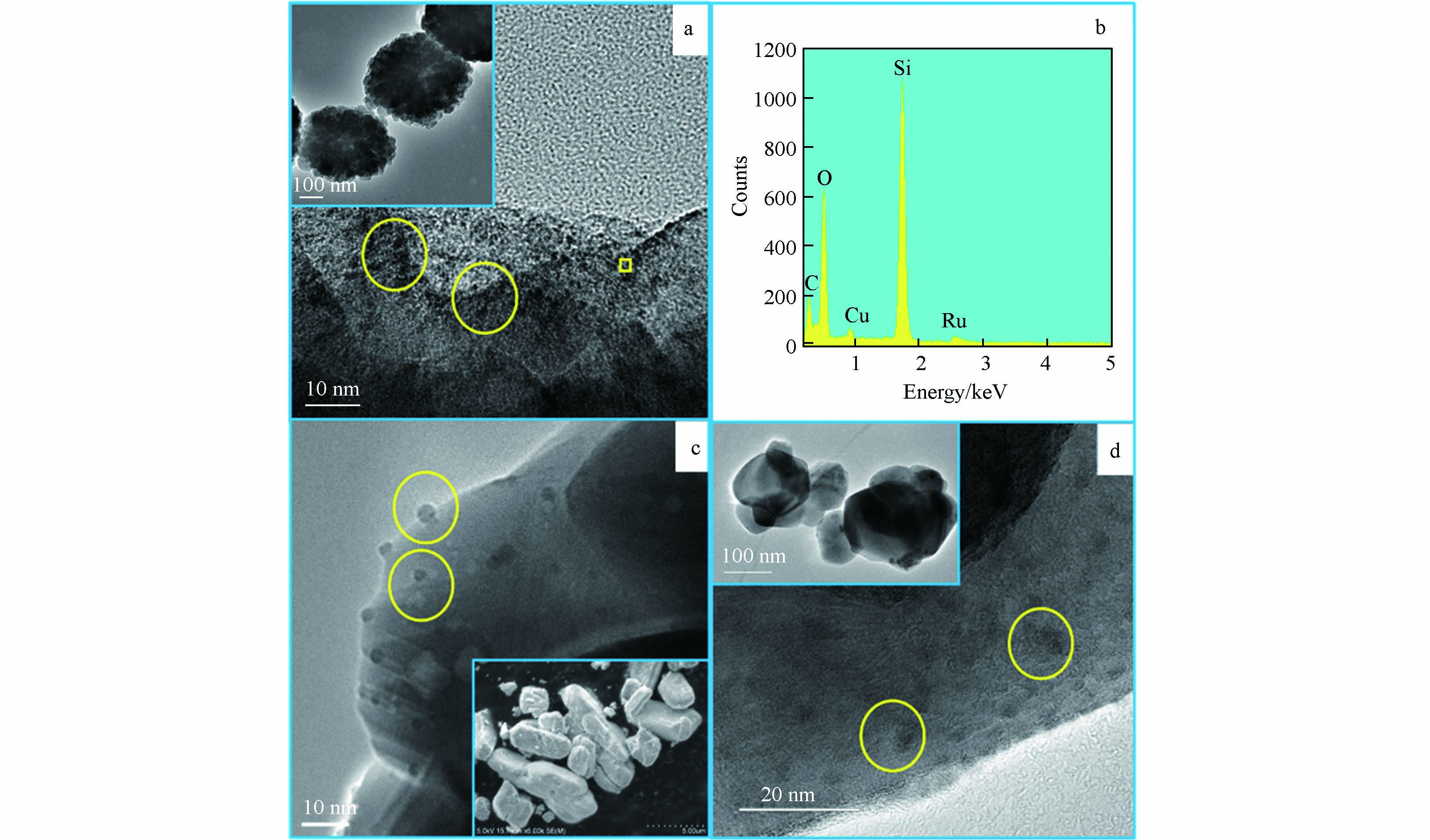 图 1 (a) Ru/ZSM-5的TEM图,(b)Ru/ZSM-5表面黄色方框内的EDAX图,(c) Ru/CeO2的TEM图,(d) Ru/TiO2的TEM图;载体的SEM图像显示在(a)、(c)和(d)的插图中.Figure 1. (a) TEM image of Ru/ZSM-5, (b) EDAX image of Ru/ZSM-5 surface in the yellow box, (c) TEM image of Ru/CeO2, and (d) TEM image of Ru/TiO2. The SEM images of supports were shown in the insets of (a), (c) and (d).表 1 催化剂及其载体的性质Table 1. Characteristics of synthesized catalysts and supports
图 1 (a) Ru/ZSM-5的TEM图,(b)Ru/ZSM-5表面黄色方框内的EDAX图,(c) Ru/CeO2的TEM图,(d) Ru/TiO2的TEM图;载体的SEM图像显示在(a)、(c)和(d)的插图中.Figure 1. (a) TEM image of Ru/ZSM-5, (b) EDAX image of Ru/ZSM-5 surface in the yellow box, (c) TEM image of Ru/CeO2, and (d) TEM image of Ru/TiO2. The SEM images of supports were shown in the insets of (a), (c) and (d).表 1 催化剂及其载体的性质Table 1. Characteristics of synthesized catalysts and supports平均粒径/μmAverage diameter 比表面积/(m2·g−1)BET Surface area 微孔表面积/(m2·g−1)Micropore surface area 外比表面积/(m2·g−1)External surface area 孔径/nmPore size 孔体积/(m3·g−1)Pore volume 微孔体积/(m3·g−1)Micropore volume ZSM-5 0.5 461 323 138 0.5 0.386 0.132 Ru/ZSM-5 0.5 407 280 127 0.5 0.272 0.088 TiO2 0.15 4.87 — — — — — Ru/TiO2 0.15 4.70 — — — — — CeO2 30 4.53 — — — — — Ru/CeO2 30 4.87 — — — — — 2.2 非均相钌催化剂的催化性能
已有研究证明Fe(Ⅵ)氧化有机微污染物符合二级反应动力学,因此本研究假设在有催化剂或没有催化剂的情况下,Fe(Ⅵ)氧化苯酚的反应在初始阶段遵循二级反应. 苯酚降解可能发生在溶液中(即非催化反应)和/或催化剂表面(即催化反应). 反应动力学方程1为简化的动力学模型,该模型同时考虑了催化反应和非催化反应.
−d[phenol]dt=ku[Fe(Ⅵ)][phenol]+kc[Fe(Ⅵ)][catalyst][phenol]=(ku+kc[catalyst])[Fe(Ⅵ)][phenol]=kT[Fe(Ⅵ)][phenol]=kobs[phenol] (1) 式中,ku(L·mol−1·min−1)为非催化反应的二级速率常数,kc(L·mol−1·min−1)为催化反应的二级速率常数;kT(L·mol−1·min−1)是整个反应的表观二级速率常数;kobs(min−1)等于kT[Fe(Ⅵ)]. 在以前的研究中,Fe(Ⅵ)浓度随时间的变化是通过紫外分光光度计在510 nm测量的,但在本研究中,由于固体催化剂的干扰,无法测定溶液中Fe(Ⅵ)的浓度.
如图2所示,Ru/ZSM-5、Ru/CeO2和Ru/TiO2催化剂加入后,kobs随催化剂用量的增加呈线性增加. 当Ru/ZSM-5的投加量从0增加到0.5 g·L−1时,kobs几乎增加了10倍. Ru/ZSM-5的Ru载量最低(0.69‰),但其催化效能与另外两种催化剂相当。由于ZSM-5比表面积远高于TiO2和CeO2,且钌纳米颗粒在ZSM-5载体上有良好分散性. 已有研究证明CeO2、TiO2和 ZSM-5作为载体,本身不会对钌催化效果产生影响[11]. 虽然载体本身对非均相钌催化剂的性能影响不大,但决定了钌纳米颗粒的分散性[8],而钌的分散性对其催化性能起着决定性作用。
2.3 pH值的影响
不同pH值下,Fe(Ⅵ)存在不同酸碱形态(pKa1 = 3.5,pKa2 = 7.3)[12],且不同形态的Fe(Ⅵ)活性不同. 苯酚(PhOH)也存在分子态和电离态(pKa = 10),在pH 5.0—9.0范围内,苯酚主要以分子态PhOH存在,因此可以忽略其电离态. 假设不同形态的Fe(Ⅵ)通过平行反应对PhOH进行氧化(反应 2—4):
H2FeO4+PhOHkα1,β1→products (2) HFeO−4+PhOHkα2,β1→products (3) FeO2−4+PhOHkα3,β1→products (4) 在不投加催化剂的情况下,当pH从5.0升高到7.0时,kobs从3.74×10−2 min−1增加到7.89×10−2 min−1,随着pH进一步升高到9.0,kobs从7.89×10−2 min−1下降到6.40×10−2 min−1(图3). 以往的研究证明HFeO4−比FeO42−的反应活性更高,但在pH 5.0和6.0下kobs相对较低,这可能是由于在低pH条件下Fe(Ⅵ)会快速自分解[12].
在3种催化剂中,选择Ru/ZSM-5作为模型催化剂来评估pH对Fe(Ⅵ)氧化苯酚性能的影响. 如图3所示,Ru/ZSM-5催化Fe(Ⅵ) 氧化苯酚的动力学也表现出很强的pH依赖性. 在pH 5.0—9.0范围内,Ru/ZSM-5极大地提高了苯酚的去除速率. 除pH 7.0外,Ru/ZSM-5催化Fe(Ⅵ)氧化苯酚的kobs (min−1)随pH升高而降低. 这是由于随着pH的升高,Fe(Ⅵ)氧化电位逐渐降低,因此生成的Rux+的量也就相应逐渐下降,最终使得催化效果下降. 在pH 7.0时,Ru/ZSM-5催化效能升高,这可能是因为在pH 7.0时,钌的催化活性较高[13].
2.4 催化机理
研究表明,在Fe(Ⅵ)氧化过程中,可能有中间态Fe(Ⅳ)、Fe(Ⅴ)和羟基自由基(HO·)等反应活性中间体[14]. 高铁酸盐氧化咖啡因过程中,主要是中间价态铁Fe(Ⅴ)和Fe(Ⅳ)在发挥氧化效能,而Fe(Ⅵ)不能降解咖啡因[15]. 因此,本文选择咖啡因作为探针化合物,检测和评估Fe(Ⅴ)和Fe(Ⅳ)对Fe(Ⅵ)-Ru/ZSM-5体系的贡献. 如图4所示,由于Ru/ZSM-5的存在,Fe(Ⅵ)对咖啡因的降解被完全抑制. 因此,可以排除 Fe(Ⅵ)-Ru/ZSM-5体系中Fe(Ⅴ)和Fe(Ⅳ)的贡献. 已有研究证明[16],Fe(Ⅵ)氧化过程中产生的HO·对有机物的降解作用可以忽略不计. 因此,排除了HO·对苯酚降解的贡献.
在高锰酸钾氧化的过程中,钌纳米颗粒具有电子穿梭的作用[8]. 简而言之,RuⅢ被高锰酸盐氧化成更高的氧化态RuⅦ,其作为氧化物种被有机微污染物还原到其初始状态RuⅢ. 因此,本研究假设Ru催化Fe(Ⅵ)氧化过程中的活性物种也是RuⅦ. 本文通过投加KRuO4,评估了RuⅦ对Fe(Ⅵ)氧化苯酚的影响. 在pH 7.0下,单独RuⅦ降解苯酚速率比Fe(Ⅵ)更高,但其对咖啡因的降解几乎没有影响(图5). Fe(Ⅵ)/RuⅢ降解苯酚的动力学规律与Fe(Ⅵ)/RuⅦ相同,但Fe(Ⅵ)/RuⅦ的反应速率常数更大. 这是因为Fe(Ⅵ)/RuⅦ中的Fe(Ⅵ)和RuⅦ都参与苯酚降解,而Fe(Ⅵ)/RuⅢ中部分Fe(Ⅵ)用于转化RuⅢ为中间态RuⅦ. 可以确定RuⅦ是Ru催化Fe(Ⅵ)氧化的主要活性物种,也是降解有机微污染物的选择性氧化剂[12].
2.5 催化剂的稳定性
在催化反应和工业应用中,催化剂的可重复使用性和稳定性至关重要. 因此本文评估了Ru/CeO2、 Ru/TiO2和Ru/ZSM-5连续使用10次的稳定性(图6). 在Ru/CeO2和Ru/TiO2催化体系中,苯酚的去除率始终高于92%;而当催化剂为Ru/ZSM-5时,在前6次实验中苯酚的去除率保持不变,但从第6次到第10次循环实验中,苯酚的去除率从98.1%逐渐下降到80.0%. 经过10次循环使用后,Ru/ZSM-5、Ru/CeO2和Ru/TiO2中Ru负载量分别从0.69‰降至0.65‰、0.80‰至0.77‰、0.94‰至0.84‰. 因此,Ru的泄露并不是Ru/ZSM-5性能下降的主要原因. Fe(Ⅵ)的主要还原产物是Fe(Ⅲ),即氢氧化铁沉淀物,这些沉淀物可能吸附在催化剂表面,导致催化剂部分活性位点被覆盖. ZSM-5是一种中孔沸石,具有较高的表面积,因此对氢氧化铁的吸附能力更高(表1). ICP结果证实在使用后的Ru/ZSM-5上存在Fe元素,质量占比为0.04‰,而Ru/CeO2和Ru/TiO2上的Fe可以忽略不计. 因此,Ru/ZSM-5 性能下降可能主要与沉积的氢氧化铁掩盖了Ru/ZSM-5表面的活性位点有关. Ru/TiO2和Ru/CeO2稳定性好,有利于其工程或中试应用,但应尽量避免氢氧化铁在催化剂表面沉积.
3. 结论(Conclusion)
Ru/ZSM-5、Ru/CeO2和Ru/TiO2可以有效催化Fe(Ⅵ)氧化降解苯酚,且催化效能随催化剂用量线性增加. 钌纳米颗粒的良好分散性是其获得较好催化性能的关键,因此,在未来研究中,单原子钌基催化剂具有广阔前景. Ru催化Fe(Ⅵ)氧化降解苯酚的动力学表现出很强的pH依赖性. Ru催化Fe(Ⅵ)氧化降解苯酚过程中的主要活性物质为RuⅦ和Fe(Ⅵ). Ru/TiO2和Ru/CeO2的稳定性优于Ru/ZSM-5,有利于其中试或工程实践中的应用.
-
表 1 该研究采样点信息表
Table 1. Information table of sampling sites in this study
采样环节Sampling link 采样位置Sampling location 采样方式Sampling method 治理措施Governance measures 样品数量/个Number of samples 底漆车间 距生产线约1 m处 无组织采样 — 2 修色车间 距生产线约1 m处 无组织采样 — 2 面漆车间 距生产线约1 m处 无组织采样 — 2 木材加工车间 距生产线约1 m处 无组织采样 — 1 厂房外 车间门外约1 m处 无组织采样 — 1 排污烟囱A 底漆车间废气排气口 有组织采样 水过滤+活性炭吸附 2 排污烟囱B 修色车间与面漆车间废气排气口 有组织采样 2 表 2 不同文献VOCs排放特征组分对比表
Table 2. Comparison of VOCs Components emission from different documents
地区Region 涂料类型Coating type 主要成分Main components 主要物种Major species 主要排放环节Main emission links 文献来源Literature source 天津市 油性涂料 芳香烃(47.48%—46.37%)、OVOCs(37.72%—39.86%) 3#企业 乙酸正丁酯(27.90%)、乙苯(22.00%)、环己酮(9.31%)、邻二甲苯(9.20%)、环己烷(7.20%)、对二甲苯(6.81%)、间乙基甲苯(6.42%)、甲苯(1.82%) 涂装过程中涂料、稀释剂和固化剂等含有VOCs的原辅料挥发 Liu等[17] 油性涂料 4#企业 乙苯(27.40%)、乙酸乙酯(21.20%)、环己酮(11.20%)、乙酸正丁酯(7.40%)、环己烷(5.80%)、对二甲苯(5.72%)、邻二甲苯(5.37%)、苯乙烯(4.87%) 河北省 溶剂型涂料 芳香烃(14.7%—88.3%)、OVOCs(10.1%—64.7%) 车间 乙酸丁酯(33.7%)、邻二甲苯(15.8%)、对二甲苯(15.3%)、乙酸乙酯(11.4%)、乙苯(9.9%)、甲苯(5.2%)、丙酮(2.4%)、1,2-二氯乙烷(1.6%)、2-丁酮(0.6%)、乙醛(0.5%) 喷涂 王瑞鹏等[34] 溶剂型涂料 排口 乙酸乙酯(51.1%)、环己酮(7.0%)、对二甲苯(6.5%)、1,2-二氯乙烷(5.4%)、三氯甲烷(4.3%)、乙苯(4.0%)、邻二甲苯(3.9%)、乙酸丁酯(3.0%)、甲苯(2.4%)、正辛烷(1.8%) 北京市 水性涂料 OVOCs(55.08%)、芳香烃(18.98%)、烷烃(17.42%) — 乙醇(36.71%)、乙酸乙酯(8.22%)、丙酮(7.77%)、二氯甲烷(9%)、间/对二甲苯(8%)、环己烷(5%)、甲苯(5%)、邻二甲苯(5%)、2-甲基戊烷(4%)、乙苯(4%) 底漆、面漆、色漆 方莉等[35] 广东省 溶剂型涂料 芳香烃(41.91%—60.67%)、OVOCs(24.75%—41.29%) 排口 苯乙烯(14.68%)、乙酸丁酯(13.07%)、甲缩醛(9.22%)、间/对二甲苯(8.85%)、甲苯(8.61%)、乙苯(7.02%)、二氯甲烷(5.05%)、邻二甲苯(4.65%)、正己烷(4.30%)、乙酸乙酯(3.63%) 喷涂+晾干废气 曾春玲等[36] 水性涂料 芳香烃(15.80%—23.10%)、OVOCs(54.02%—62.10%) 排口 甲缩醛(14.61%)、二氯甲烷(13.29%)、丙二醇单甲醚乙酸酯(11.81%)、甲苯(9.65%)、乙酸丁酯(9.41%)、乙酸乙酯(7.59%)、异丁烷(5.37%)、乙苯(3.89%)、间/对二甲苯(3.42%)、邻二甲苯(2.49%) 喷涂+烘干废气 溶剂型UV涂料 芳香烃(42.51%—43.00%)、OVOCs(41.34%—43.21%) 排口 乙酸丁酯(15.36%)、间/对二甲苯(11.85%)、甲苯(11.00%)、异丁烷(8.73%)、邻二甲苯(7.96%)、丙酮(6.86%)、乙苯(6.46%)、二氯甲烷(5.84%)、苯乙烯(5.48%)、甲缩醛(4.70%) 辊涂废气 水性UV涂料 OVOCs(55.23%—64.81%)、芳香烃(14.78%—16.85%) 排口 乙酸丁酯(20.56%)、丙二醇单甲醚乙酸酯(12.98%)、乙酸乙烯酯(12.32%)、正己烷(7.36%)、2-丁酮(5.44%)、1,2,3-三甲苯(5.38%)、反式-1,3-二氯丙烯(4.49%)、苯乙烯(4.43%)、丙酮(4.16%)、1,1-二氯乙烷(3.75%) 辊涂废气 广东省 粉末涂料 OVOCs(42.98%—46.45%)、芳香烃(24.72%—26.83%) 排口 3-乙氧基丙酸乙酯(20.19%)、乙酸丁酯(15.73%)、1-戊烯(12.38%)、间/对二甲苯(7.89%)、二氯甲烷(6.67%)、甲苯(5.52%)、丙二醇单甲醚乙酸酯(5.39%)、2,2-二甲基己烷(4.55%)、正庚烷(4.53%)、邻二甲苯(4.40%) 喷粉废气 曾春玲等[36] 德州市 未指明 芳香烃(77.0%)、OVOCs(22.0%) — 乙酸丁酯、乳酸乙酯、二甲苯、异丙醇、甲苯、乙苯、丙二醇单甲醚乙酸酯、丙酮、正己烷、苯乙烯、苯 喷漆、热压、烘干等 雒瑞等[37] 运城市 PU型涂料 芳香烃(27.2%—68.0%)、OVOCs(13.0%—30.0%)、烷烃(10.0%—45.2%) 车间 乙苯(24.01%)、间/对二甲苯(19.56%)、乙酸乙酯(16.05%)、邻二甲苯(12.78%)、辛烷(4.67%)、甲苯(3.43%)、乙醇(2.54%)、丁烯酮(2.52%)、丙烷(2.13%)、戊烷(1.81%) 底漆、面漆、修色 该研究 PU型涂料 排口 乙苯(18.10%)、间/对二甲苯(15.73%)、乙酸乙酯(14.65%)、邻二甲苯(11.55%)、辛烷(9.77%)、丁烯酮(7.07%)、乙醇(5.59%)、丙烷(2.83%)、戊烷(2.26%)、异戊烷(1.96%) -
[1] ZHAO M, ZHANG Y, PEI C, et al. Worsening ozone air pollution with reduced NOx and VOCs in the Pearl River Delta region in autumn 2019: Implications for national control policy in China[J]. Journal of Environmental Management, 2022, 324: 116327. doi: 10.1016/j.jenvman.2022.116327 [2] KONG L, LUO T Z, JIANG X, et al. Seasonal variation characteristics of VOCs and their influences on secondary pollutants in Yibin, southwest China[J]. Atmosphere, 2022, 13(9): 1389. doi: 10.3390/atmos13091389 [3] CAO J, SITU S P, HAO Y F, et al. Enhanced summertime ozone and SOA from biogenic volatile organic compound (BVOC) emissions due to vegetation biomass variability during 1981-2018 in China[J]. Atmospheric Chemistry and Physics, 2022, 22(4): 2351-2364. doi: 10.5194/acp-22-2351-2022 [4] 王迪, 赵文娟, 张玮琦, 等. 溶剂使用源挥发性有机物排放特征与污染控制对策[J]. 环境科学研究, 2019, 32(10): 1687-1695. WANG D, ZHAO W J, ZHANG W Q, et al. Emission profile and control countermeasures of volatile organic compounds in solvent-using source[J]. Research of Environmental Sciences, 2019, 32(10): 1687-1695 (in Chinese).
[5] 修光利, 吴应, 王芳芳, 等. 我国固定源挥发性有机物污染管控的现状与挑战[J]. 环境科学研究, 2020, 33(9): 2048-2060. XIU G L, WU Y, WANG F F, et al. Current status and challenge for control of volatile organic compounds (VOCs) from stationary sources in China[J]. Research of Environmental Sciences, 2020, 33(9): 2048-2060 (in Chinese).
[6] KUMAR V, SINHA V. Season-wise analyses of VOCs, hydroxyl radicals and ozone formation chemistry over north-west India reveal isoprene and acetaldehyde as the most potent ozone precursors throughout the year[J]. Chemosphere, 2021, 283: 131184. doi: 10.1016/j.chemosphere.2021.131184 [7] LIU N W, LI X L, REN W H, et al. Concentration characteristics and photochemical reactivities of VOCs in Shenyang, China[J]. Atmosphere, 2021, 12(10): 1240. doi: 10.3390/atmos12101240 [8] WANG H, HAO R, FANG L, et al. Study on emissions of volatile organic compounds from a typical coking chemical plant in China[J]. Science of the Total Environment, 2021, 752: 141927. doi: 10.1016/j.scitotenv.2020.141927 [9] 刘锐泽, 方渊, 张韬, 等. 青岛市夏季VOCs污染特征及来源解析[J]. 环境工程技术学报, 2021, 11(6): 1041-1048. LIU R Z, FANG Y, ZHANG T, et al. Characteristics and source analysis of VOCs pollution in summer in Qingdao[J]. Journal of Environmental Engineering Technology, 2021, 11(6): 1041-1048 (in Chinese).
[10] DHITAL N B, YANG H-H, WANG L C, et al. VOCs emission characteristics in motorcycle exhaust with different emission control devices[J]. Atmospheric Pollution Research, 2019, 10(5): 1498-1506. doi: 10.1016/j.apr.2019.04.007 [11] 张利慧, 毋振海, 李斌, 等. 北京市城区春季大气挥发性有机物污染特征[J]. 环境科学研究, 2020, 33(3): 526-535. ZHANG L H, WU Z H, LI B, et al. Pollution characterizations of atmospheric volatile organic compounds in spring of Beijing urban area[J]. Research of Environmental Sciences, 2020, 33(3): 526-535 (in Chinese).
[12] CHANDRA B P, McCLURE C D, MULLIGAN J, et al. Optimization of a method for the detection of biomass-burning relevant VOCs in urban areas using thermal desorption gas chromatography mass spectrometry[J]. Atmosphere, 2020, 11(3): 276. doi: 10.3390/atmos11030276 [13] YANG H H, GUPTA S K, DHITAL N B, et al. Comparative investigation of coal- and oil-fired boilers based on emission factors, ozone and secondary organic aerosol formation potentials of VOCs[J]. Journal of Environmental Sciences, 2020, 92: 245-255. doi: 10.1016/j.jes.2020.02.024 [14] WANG M, LI S, ZHU R, et al. On-road tailpipe emission characteristics and ozone formation potentials of VOCs from gasoline, diesel and liquefied petroleum gas fueled vehicles[J]. Atmospheric Environment, 2020, 223: 117294. doi: 10.1016/j.atmosenv.2020.117294 [15] SABER A N, ZHANG H F, CERVANTES-AVILÉS P, et al. Emerging concerns of VOCs and SVOCs in coking wastewater treatment processes: Distribution profile, emission characteristics, and health risk assessment[J]. Environmental Pollution, 2020, 265: 114960. doi: 10.1016/j.envpol.2020.114960 [16] 李世杰, 殷宝辉, 赵雪艳, 等. 家具板材排放VOCs成分谱及排放因子研究[J]. 环境科学研究, 2020, 33(4): 859-867. LI S J, YIN B H, ZHAO X Y, et al. Composition and emission factors of VOCs released from wood based panels[J]. Research of Environmental Sciences, 2020, 33(4): 859-867 (in Chinese).
[17] LIU Z Y, CAO Z Q, ZHAO J R, et al. Characteristics of VOCs emission components in typical solvents source industries in Tianjin[J]. IOP Conference Series: Earth and Environmental Science, 2021, 781(3): 032010. doi: 10.1088/1755-1315/781/3/032010 [18] 包亦姝, 王斌, 邓也, 等. 成都市典型有机溶剂使用行业VOCs组成成分谱及臭氧生成潜势研究[J]. 环境科学学报, 2020, 40(1): 76-82. BAO Y S, WANG B, DENG Y, et al. Source profiles and ozone formation potential of VOCs emitted from typical industries using organic solvents in Chengdu[J]. Acta Scientiae Circumstantiae, 2020, 40(1): 76-82 (in Chinese).
[19] QI Y, SHEN L, ZHANG J, et al. Species and release characteristics of VOCs in furniture coating process[J]. Environmental Pollution, 2019, 245: 810-819. doi: 10.1016/j.envpol.2018.11.057 [20] TONG R, ZHANG L, YANG X, et al. Emission characteristics and probabilistic health risk of volatile organic compounds from solvents in wooden furniture manufacturing[J]. Journal of Cleaner Production, 2019, 208: 1096-1108. doi: 10.1016/j.jclepro.2018.10.195 [21] 齐一谨, 倪经纬, 赵东旭, 等. 郑州市典型工业企业VOCs排放特征及风险评估[J]. 环境科学, 2020, 41(7): 3056-3065. QI Y J, NI J W, ZHAO D X, et al. Emission characteristics and risk assessment of volatile organic compounds from typical factories in Zhengzhou[J]. Environmental Science, 2020, 41(7): 3056-3065 (in Chinese).
[22] YUAN B, SHAO M, LU S, et al. Source profiles of volatile organic compounds associated with solvent use in Beijing, China[J]. Atmospheric Environment, 2010, 44(15): 1919-1926. doi: 10.1016/j.atmosenv.2010.02.014 [23] MO Z, SHAO M, LU S, et al. Characterization of non-methane hydrocarbons and their sources in an industrialized coastal city, Yangtze River Delta, China[J]. Science of the Total Environment, 2017, 593/594: 641-653. doi: 10.1016/j.scitotenv.2017.03.123 [24] CARTER W P L. Development of the SAPRC-07 chemical mechanism[J]. Atmospheric Environment, 2010, 44(40): 5324-5335. doi: 10.1016/j.atmosenv.2010.01.026 [25] CARTER W P L. Development of ozone reactivity scales for volatile organic compounds[J]. Air & Waste, 1994, 44(7): 881-899. [26] 邱婉怡, 刘禹含, 谭照峰, 等. 基于中国四大城市群计算的最大增量反应活性[J]. 科学通报, 2020, 65(7): 610-621. doi: 10.1360/TB-2019-0598 QIU W Y, LIU Y H, TAN Z F, et al. Calculation of maximum incremental reactivity scales based on typical megacities in China[J]. Chinese Science Bulletin, 2020, 65(7): 610-621 (in Chinese). doi: 10.1360/TB-2019-0598
[27] GHADIMI S, ZHU H W, DURBIN T D, et al. The impact of hydrogenated vegetable oil (HVO) on the formation of secondary organic aerosol (SOA) from in-use heavy-duty diesel vehicles[J]. Science of the Total Environment, 2022, 822: 153583. doi: 10.1016/j.scitotenv.2022.153583 [28] LIU R, CHEN J, LI G, et al. Cutting down on the ozone and SOA formation as well as health risks of VOCs emitted from e-waste dismantlement by integration technique[J]. Journal of Environmental Management, 2019, 249: 107755. doi: 10.1016/j.jenvman.2018.07.034 [29] LI J, DENG S, LI G, et al. VOCs characteristics and their ozone and SOA formation potentials in autumn and winter at Weinan, China[J]. Environmental Research, 2022, 203: 111821. doi: 10.1016/j.envres.2021.111821 [30] SUN J, WU F, HU B, et al. VOC characteristics, emissions and contributions to SOA formation during hazy episodes[J]. Atmospheric Environment, 2016, 141: 560-570. doi: 10.1016/j.atmosenv.2016.06.060 [31] GROSJEAN E, GROSJEAN D. The reaction of unsaturated aliphatic oxygenates with ozone[J]. Journal of Atmospheric Chemistry, 1999, 32(2): 205-232. doi: 10.1023/A:1006122000643 [32] 吕子峰, 郝吉明, 段菁春, 等. 北京市夏季二次有机气溶胶生成潜势的估算[J]. 环境科学, 2009, 30(4): 969-975. LÜ Z F, HAO J M, DUAN J C, et al. Estimate of the formation potential of secondary organic aerosol in Beijing summertime[J]. Environmental Science, 2009, 30(4): 969-975 (in Chinese).
[33] DECHAPANYA W, RUSSELL M, ALLEN D T. Estimates of anthropogenic secondary organic aerosol formation in Houston, texas special issue of aerosol science and technology on findings from the fine particulate matter supersites program[J]. Aerosol Science and Technology, 2004, 38(sup1): 156-166. doi: 10.1080/02786820390229462 [34] 王瑞鹏, 王晓琦, 程水源, 等. 末端治理对工业涂装行业VOCs排放的影响[J]. 中国环境科学, 2022, 42(2): 593-600. WANG R P, WANG X Q, CHENG S Y, et al. Influence of end-of-pipe treatment on VOCs emission in industrial coating industries[J]. China Environmental Science, 2022, 42(2): 593-600 (in Chinese).
[35] 方莉, 刘文文, 陈丹妮, 等. 北京市典型溶剂使用行业VOCs成分谱[J]. 环境科学, 2019, 40(10): 4395-4403. FANG L, LIU W W, CHEN D N, et al. Source profiles of volatile organic compounds(VOCs) from typical solvent-based industries in Beijing[J]. Environmental Science, 2019, 40(10): 4395-4403 (in Chinese).
[36] 曾春玲, 邵霞, 刘锐源, 等. 广东省家具行业基于涂料类型的VOCs排放特征及其环境影响[J]. 环境科学, 2021, 42(10): 4641-4649. ZENG C L, SHAO X, LIU R Y, et al. Coating-derived VOCs emission characteristics and environmental impacts from the furniture industry in Guangdong Province[J]. Environmental Science, 2021, 42(10): 4641-4649 (in Chinese).
[37] 雒瑞, 张巍, 张培勇, 等. 德州市典型溶剂使用行业VOCs排放特征及末端治理技术研究[J]. 涂料工业, 2020, 50(9): 67-75. LUO R, ZHANG W, ZHANG P Y, et al. Study on emission characteristics and end-control measurements for VOCs from typical solvent-usage industries in Dezhou city[J]. Paint & Coatings Industry, 2020, 50(9): 67-75 (in Chinese).
[38] 秦华, 谢建辉, 杜天君, 等. 济南市典型家具企业VOCs排放特征及O3生成贡献分析[J]. 环境保护科学, 2021, 47(3): 138-145. QIN H, XIE J H, DU T J, et al. Analysis on VOCs emission characteristics and ozone generation contribution of typical furniture enterprises in Jinan[J]. Environmental Protection Science, 2021, 47(3): 138-145 (in Chinese).
[39] 张嘉妮, 曾春玲, 刘锐源, 等. 家具企业挥发性有机物排放特征及其环境影响[J]. 环境科学, 2019, 40(12): 5240-5249. ZHANG J N, ZENG C L, LIU R Y, et al. Volatile organic compound emission characteristics of furniture manufacturing enterprises and the influence on the atmospheric environment[J]. Environmental Science, 2019, 40(12): 5240-5249 (in Chinese).
-




 下载:
下载:

